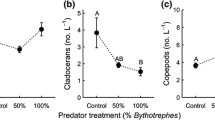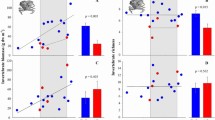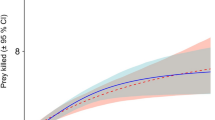Abstract
Invasive predators can disrupt important predator–prey dynamics thereby facilitating invasions into prey communities. Lower latitude food webs can have strong consumer pressure and top-down control due to trophic complexity, however, and thus could be more robust to alterations by introduced predators than higher latitude food webs. We compared the strength of a marine invasive species-induced trophic cascade in a temperate and subtropical system, hypothesizing that a non-native tertiary consumer could facilitate non-native basal prey establishment through the consumption of a native secondary consumer. We further predicted that the ecological importance of this cascade may be reduced in the subtropical community relative to the temperate community due to stronger consumer pressure from top predators. Using marine invertebrates, we conducted experiments in temperate Long Island Sound, Connecticut, USA and subtropical Indian River Lagoon, Florida, USA to test our hypothesis. We further examined predation pressure on tertiary consumers in order to assess any top-down control of the invasive species-induced cascade from higher trophic levels. We found evidence of a trophic cascade in both regions, but it was only maintained under ambient predation pressure in the temperate region. Our results also suggest that strong predation pressure on the non-native portunid crabs in the subtropical region may help explain the weakened cascade under ambient conditions. Studying predator invasions in the context of full communities and from a macroecological perspective can be used to predict both local and large scale patterns of invasion, and lead to identifying locations where high-impact invasions are more likely to occur.




Similar content being viewed by others
References
Baeta A, Cabral HN, Neto JM et al (2005) Biology, population dynamics and secondary production of the green crab Carcinus maenas (L.) in a temperate estuary. Estuar Coast Shelf Sci 65:43–52. https://doi.org/10.1016/j.ecss.2005.05.004
Baynes TW, Szmant AM (1989) Effect of current on the sessile benthic community structure of an artificial reef. Bull Mar Sci 44:545–566
Berger MS (1998) Predator–prey relations between the green crab, Carcinus maenas and three small gastropods, Mitrella lunata, Anachis lafresnayi, and Anachis avara. Senior Honors Thesis, University of Connecticut, Storrs, CT
Bertness MD, Garrity SD, Levings SC (1981) Predation pressure and gastropod foraging: a tropical-temperate comparison. Evolution (N Y) 35:995. https://doi.org/10.2307/2407870
Blum JC, Chang AL, Liljesthrom M, Schenk ME, Steinberg MK, Ruiz GM (2007) The non-native solitary ascidian Ciona intestinalis (L.) depresses species richness. J Exp Mar Biol Ecol 342(1):5–14. https://doi.org/10.1016/j.jembe.2006.10.010
Bouchemousse S, Bishop JDD, Viard F (2016) Contrasting global genetic patterns in two biologically similar, widespread and invasive Ciona species (Tunicata, Ascidiacea). Sci Rep 6:24875. https://doi.org/10.1038/srep24875
Byrnes J, Stachowicz JJ, Hultgren KM et al (2005) Predator diversity strengthens trophic cascades in kelp forests by modifying herbivore behaviour. Ecol Lett 9:61. https://doi.org/10.1111/j.1461-0248.2005.00842.x
Carlsson NOL, Bustamante H, Strayer DL, Pace ML (2011) Biotic resistance on the increase: native predators structure invasive zebra mussel populations. Freshw Biol 56:1630–1637. https://doi.org/10.1111/j.1365-2427.2011.02602.x
Carver CE, Chisholm A, Mallet AL (2003) Strategies to mitigate the impact of Ciona intestinalis (L.) biofouling on shellfish production. J Shellfish Res 22:621–631
Cohen AN (2011) The exotics guide: non-native marine species of the North American Pacific Coast. Center for research on aquatic bioinvasions, Richmond, CA, and San Francisco Estuary Institute, Oakland, CA. Revised September 2011. http://www.exoticsguide.org
Cooper RN, Wissel B (2012a) Loss of trophic complexity in saline prairie lakes as indicated by cascades in kelp forests by modifying herbivore behaviour. Ecol Lett. https://doi.org/10.1111/j.1461-0248.2005.00842.x
Cooper RN, Wissel B (2012b) Loss of trophic complexity in saline prairie lakes as indicated by stable-isotope based community-metrics. Aquat Biosyst. https://doi.org/10.1186/2046-9063-8-6
deRivera CE, Ruiz GM, Hines AH, Jivoff P (2005) Biotic resistance to invasion: native predator limits abundance and distribution of an introduced crab. Ecology 86:3364–3376. https://doi.org/10.1890/05-0479
Dijkstra J, Harris LG, Westerman E (2007) Distribution and long-term temporal patterns of four invasive colonial ascidians in the Gulf of Maine. J Exp Mar Bio Ecol 342:61–68. https://doi.org/10.1016/j.jembe.2006.10.015
Dineen JF, Clark PF, Hines AH et al (2001) Life history, larval description, and natural history of Charybdis Hellerii (Decapoda, Brachyura, Portunidae), an Invasive Crab in the Western Atlantic. J Crustac Biol 21:774–805. https://doi.org/10.1163/20021975-99990173
Dunne JA, Brose U, Williams RJ, Martinez ND (2005) Modeling food-web dynamics: complexity–stability implications. In: Belgrano A, Scharler UM, Dunne J, Ulanowicz RE (eds) Aquatic food webs: an ecosystem approach. Oxford University Press, Oxford, pp 117–129
Dybas CL (2002) Florida’s Indian River Lagoon: an Estuary in Transition. Bioscience 52:555. https://doi.org/10.1641/0006-3568(2002)052%5b0555:FSIRLA%5d2.0.CO;2
Elton CS (1958) The ecology of invasions by animals and plants. Springer, Boston
Fautin D, Dalton P, Incze LS et al (2010) An overview of marine biodiversity in United States waters. PLoS ONE 5:e11914. https://doi.org/10.1371/journal.pone.0011914
Fine PVA (2002) The invasibility of tropical forests by exotic plants. J Trop Ecol 18:687–705. https://doi.org/10.1017/S0266467402002456
Finke DL, Denno RF (2004) Predator diversity dampens trophic cascades. Nature 429:407–410. https://doi.org/10.1038/nature02554
Freeman AS, Frischeisen A, Blakeslee AM (2016) Estuarine fouling communities are dominated by nonindigenous species in the presence of an invasive crab. Biol Invasions 18:1653–1665. https://doi.org/10.1007/s10530-016-1108-3
Freestone AL, Osman RW, Ruiz GM, Torchin ME (2011) Stronger predation in the tropics shapes species richness patterns in marine communities. Ecology 92:983–993. https://doi.org/10.1890/09-2379.1
Freestone AL, Ruiz GM, Torchin ME (2013) Stronger biotic resistance in tropics relative to temperate zone: effects of predation on marine invasion dynamics. Ecology 94:1370–1377. https://doi.org/10.1890/12-1382.1
Galil BS, Clark PF, Carlton JT (eds) (2011) In the wrong place—Alien Marine Crustaceans: Distribution. Biology and Impacts, Springer
Grabowski JH, Hughes AR, Kimbro DL (2008) Habitat complexity influences cascading effects of multiple predators. Ecology 89:3413–3422
Grosholz ED (2005) Recent biological invasion may hasten invasional meltdown by accelerating historical introductions. Proc Natl Acad Sci USA 102:1088–1091. https://doi.org/10.1073/pnas.0308547102
Griffen BD, Delaney DG (2007) Species invasion shifts the importance of predator dependence. Ecology 88:3012–3021
Harris MA, Moore AM, Lowen JB, DiBacco C (2017) Seasonal reproduction of the non-native vase tunicate Ciona intestinalis (Linneaus, 1767) in Nova Scotia, Canada, in relation to water temperature. Aquat Invasions 12:33–41. https://doi.org/10.3391/ai.2017.12.1.04
Hines J, Gessner MO (2012) Consumer trophic diversity as a fundamental mechanism linking predation and ecosystem functioning. J Anim Ecol 81:1146–1153. https://doi.org/10.1111/j.1365-2656.2012.02003.x4
Jeanne RL (1979) A latitudinal gradient in rates of ant predation. Ecology 60:1211. https://doi.org/10.2307/1936968
Jensen GC, McDonald PS, Armstrong DA (2007) Biotic resistance to green crab, Carcinus maenas, in California bays. Mar Biol 151:2231–2243. https://doi.org/10.1007/s00227-007-0658-4
Kaluza P, Kölzsch A, Gastner MT, Blasius B (2010) The complex network of global cargo ship movements. J R Soc Interface 7:1093–1103. https://doi.org/10.1098/rsif.2009.0495
Karimi R, Frisk M, Fisher NS (2013) Contrasting food web factor and body size relationships with Hg and Se concentrations in marine biota. PLoS ONE 8:e74695. https://doi.org/10.1371/journal.pone.0074695
Kimbro DL, Grosholz ED, Baukus AJ et al (2009) Invasive species cause large-scale loss of native California oyster habitat by disrupting trophic cascades. Oecologia 160:563–575. https://doi.org/10.1007/s00442-009-1322-0
Kimbro DL, Cheng BS, Grosholz ED (2013) Biotic resistance in marine environments. Ecol Lett 16:821–833. https://doi.org/10.1111/ele.12106
Kimbro DL, Byers JE, Grabowski JH et al (2014) The biogeography of trophic cascades on US oyster reefs. Ecol Lett 17:845–854. https://doi.org/10.1111/ele.12293
Kurle CM, Cardinale BJ (2011) Ecological factors associated with the strength of trophic cascades in streams. Oikos 120:1897–1908. https://doi.org/10.1111/j.1600-0706.2011.19465.x
LeGresley MM, Martin JL, McCurdy P et al (2008) Non-indigenous tunicate species in the Bay of Fundy, eastern Canada. ICES J Mar Sci 65:770–774
Lejeusne C, Bock DG, Therriault TW et al (2011) Comparative phylogeography of two colonial ascidians reveals contrasting invasion histories in North America. Biol Invasions 13:635–650. https://doi.org/10.1007/s10530-010-9854-0
Lemaitre R (1995) Charybdis Hellerii (Milne Edwards, 1867), a nonindigenous portunid crab system of Florida. Proc Biol Soc Wash 108:643–648
Locke A, Hanson JM, Ellis KM et al (2007) Invasion of the southern Gulf of St. Lawrence by the clubbed tunicate (Styela clava Herdman): potential mechanisms for invasions of Prince Edward Island estuaries. J Exp Mar Bio Ecol 342:69–77. https://doi.org/10.1016/j.jembe.2006.10.016
Marczak LB, Ho CK, Wieski K et al (2011) Latitudinal variation in top-down and bottom-up control of a salt marsh food web. Ecology 92:276–281
Menge BA, Lubchenco J (1981) Community organization in temperate and tropical rocky intertidal habitats: prey refuges in relation to consumer pressure gradients. Ecol Monogr 51:429–450. https://doi.org/10.2307/2937323
Miller LP, Gaylord B (2007) Barriers to flow: the effects of experimental cage structures on water velocities in high-energy subtidal and intertidal environments. J Exp Mar Bio Ecol 344:215–228. https://doi.org/10.1016/j.jembe.2007.01.005
Moody RM, Aronson RB (2012) Predator-induced defenses in a salt-marsh gastropod. J Exp Mar Bio Ecol 413:78–86. https://doi.org/10.1016/j.jembe.2011.11.029
Myers N, Mittermeier RA, Mittermeier CG et al (2000) Biodiversity hotspots for conservation priorities. Nature 403:853–858. https://doi.org/10.1038/35002501
Osman R, Whitlatch R (1995) Predation on early ontogenetic life stages and its effect on recruitment into a marine epifaunal community. Mar Ecol Prog Ser 117:111–126. https://doi.org/10.3354/meps117111
Osman RW, Whitlatch RB (2004) The control of the development of a marine benthic community by predation on recruits. J Exp Mar Bio Ecol 311:117–145. https://doi.org/10.1016/j.jembe.2004.05.001
Pace Cole, Carpenter Kitchell (1999) Trophic cascades revealed in diverse ecosystems. Trends Ecol Evol 14:483–488
Paine RT (1966) Food web complexity and species diversity. Am Nat 100:65–75. https://doi.org/10.1086/282400
Papacostas KJ, Rielly-Carroll EW, Georgian SE, Long DJ, Princiotta SD, Quattrini AM, Reuter KE, Freestone AL (2017) Biological mechanisms of marine invasions. Mar Ecol Prog Ser 565:251–268. https://doi.org/10.3354/meps12001
Pennings SC, Silliman BR (2005) Linking biogeography and community ecology: latitudinal variation in plant-herbivore interaction strength. Ecology 86:2310–2319. https://doi.org/10.1890/04-1022
Philpott SM, Pardee GL, Gonthier DJ (2012) Cryptic biodiversity effects: importance of functional redundancy revealed through addition of food web complexity. Ecology 93:992–1001. https://doi.org/10.1890/11-1431.1
Randall J (1998) Zoogeography of shore fishes of the Indo-Pacific region. Zool Stud 37:227–268
Reed JK, Gore RH, Scotto LE, Wilson KA (1982) Community composition, structure, areal and trophic relationships of decapods associated with shallow- and deep-water Oculina varicosa Coral Reefs: studies on Decapod Crustacea from the Indian River Region of Florida, XXIV. Bull Mar Sci 32:761–786
Rodriguez LF (2006) Can invasive species facilitate native species? Evidence of how, when, and why these impacts occur. Biol Invasions 8:927–939. https://doi.org/10.1007/s10530-005-5103-3
Rogers EM (1998) The autecology of three predatory gastropods Mitrella lunata, Anachis avara, and Anachis lafresnayi. Master’s Thesis, University of Connecticut, Storrs, CT
Roman J (2006) Diluting the founder effect: cryptic invasions expand a marine invader’s range. Proc Biol Sci 273:2453–2459. https://doi.org/10.1098/rspb.2006.3597
Rosenberger LJ (2001) Phylogenetic Relationships within the Stingray Genus Dasyatis (Chondrichthyes: Dasyatidae). Copeia 2001:615–627. https://doi.org/10.1643/0045-8511(2001)001%5b0615:PRWTSG%5d2.0.CO;2
Ruiz GM, Carlton JT, Grosholz ED, Hines AH (1997) Global invasions of marine and estuarine habitats by non-indigenous species: mechanisms, extent, and consequences. Am Zool 37:621–632. https://doi.org/10.1093/icb/37.6.621
Ruiz GM, Fofonoff PW, Carlton JT et al (2000) Invasion of coastal marine communities in North America: apparent patterns, processes, and biases. Annu Rev Ecol Syst 31:481–531. https://doi.org/10.1146/annurev.ecolsys.31.1.481
Ruiz GM, Fofonoff PW, Ashton G et al (2013) Geographic variation in marine invasions among large estuaries: effects of ships and time. Ecol Appl 23:311–320
Sargent PS, Wells T, Matheson K, McKenzie CH, Deibel D (2013) First record of vase tunicate, Ciona intestinalis (Linnaeus, 1767), in coastal Newfoundland waters. Bioinvasions Records 2:89–98. https://doi.org/10.3391/bir.2013.2.2.01
Sax DF (2008) Latitudinal gradients and geographic ranges of exotic species: implications for biogeography. J Biogeogr 28:139–150. https://doi.org/10.1046/j.1365-2699.2001.00536.x
Schemske DW, Mittelbach GG, Cornell HV et al (2009) Is there a latitudinal gradient in the importance of biotic interactions? Annu Rev Ecol Evol Syst 40:245–269. https://doi.org/10.1146/annurev.ecolsys.39.110707.173430
Shurin JB, Borer ET, Seabloom EW et al (2002) A cross-ecosystem comparison of the strength of trophic cascades. Ecol Lett 5:785–791
Sih A, Bolnick DI, Luttbeg B et al (2010) Predator–prey naïveté, antipredator behavior, and the ecology of predator invasions. Oikos 119:610–621. https://doi.org/10.1111/j.1600-0706.2009.18039.x
Smithsonian Marine Station (2017) The Indian River Lagoon species inventory. http://www.sms.si.edu/irlspec/Sp_Image_Collection.htm . Accessed 1 April 2017
Son NT (2013) An annotated checklist of crabs of the superfamily Portunoidea Rafinesque, 1815 from the Philippines (Crustacea: Decopoda: Brachyura). Masters Thesis, National University of Singapore
Stachowicz JJ, Hay ME (2000) Geographic variation in camouflage specialization by a decorator crab. Am Nat 156:59–71. https://doi.org/10.1086/303366
Stoner D, Ben-Shlomo R, Rinkevich B, Weissman I (2002) Genetic variability of Botryllus schlosseri invasions to the east and west coasts of the USA. Mar Ecol Prog Ser 243:93–100. https://doi.org/10.3354/meps243093
Strong DR (1992) Are trophic cascades all wet? Differentiation and donor-control in speciose ecosystems. Ecology 73:747–754. https://doi.org/10.2307/1940154
Wagner A, Hulsmann S, Horn W et al (2013) Food-web-mediated effects of climate warming: consequences for the seasonal Daphnia dynamics. Freshw Biol 58:573–587. https://doi.org/10.1111/j.1365-2427.2012.02809.x
Wahle L (2002) Living treasures: the plants and animals of long island sound. Connecticut Sea Grant College Program, University of Connecticut, Marine Sciences Institute, Groton
Whitlatch RB, Bullard SG (2007) Introduction to the proceedings of the 1st international invasive sea squirt conference. J Exp Mar Bio Ecol 342:1–2
Williamson M, Fitter A (1996) The varying success of invaders. Ecology 77:1661–1666. https://doi.org/10.2307/2265769
Worthy GAJ, Worthy TAM, Browning N (2011) Seasonal variability in the trophic ecology of bottlenose dolphins and their potential prey in the Indian River Lagoon, FL. Part 1, Final, Fort Pierce
Yund PO, Collins C, Johnson SL (2015) Evidence of a native Northwest Atlantic COI haplotype clade in the cryptogenic colonial ascidian Botryllus schlosseri. Biol Bull 228:201–216
Acknowledgements
We thank M. McQuillan, J. Papacostas, S. Reed, and M. Vaca for field assistance; D. Janiak and R. Osman for sessile invertebrate identification assistance; ‘Team Benthos’ at the University of Connecticut for use of facilities and field sites as well as assistance with invertebrate collection; P. Petraitis, E. Cordes, R. Sanders and B. Sewall for useful feedback during the development of the project; and D. Long, K. Reuter, J. Carlton and one anonymous reviewer for helpful comments on the manuscript. This study was supported by the Smithsonian/Link Foundation fellowship program (Smithsonian Marine Station Contribution at Fort Pierce, Florida, No. 1002) and the National Science Foundation Division of Ocean Sciences under Grant #1225583.
Author information
Authors and Affiliations
Corresponding author
Electronic supplementary material
Below is the link to the electronic supplementary material.
Rights and permissions
About this article
Cite this article
Papacostas, K.J., Freestone, A.L. Stronger predation in a subtropical community dampens an invasive species-induced trophic cascade. Biol Invasions 21, 203–215 (2019). https://doi.org/10.1007/s10530-018-1819-8
Received:
Accepted:
Published:
Issue Date:
DOI: https://doi.org/10.1007/s10530-018-1819-8




